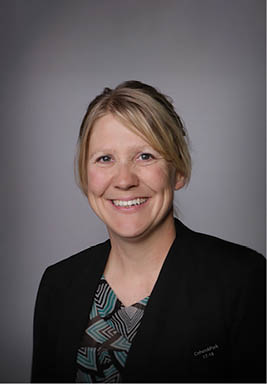We Lead

When I started my high school administrative career, I had been a teacher for five years. I decided to apply to one school six hours from our home because after hearing its administrative team speak at a conference, I knew Taft 7–12 Middle and High School in Lincoln City, OR, was where I wanted to be. What shocked me is that they wanted me, too.
Many women feel they must be ready for a position before they are willing to take that leap, but the truth is you are never fully ready. School leadership is an exciting and ever-changing occupation that requires engaging with people of multiple generations and making decisions ranging from the mundane (e.g., approving a schedule change) to the terrifying (e.g., entering a lockdown). I remember my first day as a high school assistant principal. I was sitting in my office thinking, “What do I even do?”
Well, it took the students and teachers to show up for me to figure it out. My job was to listen, love, have fun, and learn. That is not to say that with fun and great times didn’t come nights full of tears, of feeling like I was ill-equipped and didn’t belong. But the fact was that I was in the right place not because they picked me, but because in my whole heart I wanted to be there.

A little over a year ago, I co-authored a book with Rachel George, She Leads: The Women’s Guide to a Career in Educational Leadership. I recently spoke with Opal Primozich, the 2021–22 president of the Oregon Association of Student Councils, about the book, which she and I discussed at a leadership conference with more than 150 high school female leaders in our sessions. In our talk before the audience, Opal and I covered five important topics from the book. I truly feel these resonate with women at all levels of leadership.
- There is a time to lead. Have you ever found yourself at the table and wondered what to do there? Women need to know their worth and use their voice to share ideas and grow an organization. When you are new to a school, district, or grade level, it may be difficult to break into the ranks, but remember, they hired you for a reason! Exercising your voice, sharing ideas, and expressing strengths to the team builds credibility, provides confidence, and erases any doubts others may have about new leadership. When new leaders start, the organization can freeze waiting to see what change may come. The most important part of building trust is to lead with your core values and make those known to assure the organization of who you are and what you stand for as a leader. Invite others to the table to join you to grow even more leaders to support the work. Look around to see who is missing and what strengths are lacking in your leadership ranks, and seek them out to improve your organization. Your students and families need to see leaders who look like them to feel welcome. Your team’s strengths and experiences need to be diverse to reach more families, hear more voices, and become a more understanding organization.
- It’s a jungle gym. Women need to feel okay leading from where they are and taking the path that gets them to where they want to be. Do you want to be a superintendent? Your path may take you from the classroom to a high school building administrator position to the district office on up. You may decide that to be a strong superintendent you need K–12 experience, and you may decide to be an elementary school principal, too. (Being an elementary school principal made me a stronger high school principal when I transferred back.) However, you may want to be a curriculum administrator and go from the classroom to being a teacher on special assignment and then taking a curriculum position before deciding the work you really want to do is serving as a building administrator. If you want to be a high school athletic director (we need more women!) and are currently a building principal, find ways to learn about the job outside of just supervising games. Look at budgeting, hiring, scheduling, and Title IX compliance. Attend a state or national athletic directors’ conference with the AD in your building. Don’t get caught in a trap of finding “the right” path because someone else did it that way. Set your sights on the job you want and seize learning opportunities to prepare for when the time comes to make your move.
- Take risks. A major pitfall leaders make is thinking they need all the answers before pressing go. Sometimes we make a decision when we don’t have all the answers, but we do have a great idea. Try the new thing and be OK if it doesn’t work. Support your teachers who want to do the same. Celebrate the process proudly and publicly, even if it fails. When leaders build a supportive culture and model risk-taking, they not only grow personally—they also encourage teachers to try new strategies or student leaders to push themselves to try an activity that will include more students. In Brave, Not Perfect: Fear Less, Fail More, and Live Bolder, Reshma Saujani discusses how women often worry about getting it wrong. So, flip that script and talk about getting it wrong and build that resiliency so you aren’t afraid to take the risk. If it fails, get back up, reflect on what happened, don’t dwell on mistakes, and move on.
- Make it happen. Making it happen is one of the most exciting parts of the job. You took that risk and good things are going on in the building and community. When things get rocking in the right direction it is important to stop and look around. Who is making it happen? Are you doing it all alone, delegating, or asking for help? In the moment of making it happen, women can fall into the trap of not letting others help. We must all realize that great leaders surround themselves with other great leaders, and they exist at every level of the organization. Leaders delegate tasks to avoid burnout and to grow organizational capacity. When we don’t delegate and ask for help, we inadvertently rob others of the joy of making it happen. Sometimes leaders get so busy making it happen all alone that not only do they burn out, but they also forget to celebrate the awesome work of their colleagues. Celebrating alone can feel nice, but celebrating with a team of leaders is amazing.
- Be authentic. There are lots of people who have ideas of how leadership should look. The way a leader presents herself says a lot about her school, community, and position. However, leaders must be authentic, or eventually they will be miserable. Leadership cannot be a show. I am most authentic and comfortable presenting as my messy self. In a high school graduation speech, I thanked the seniors who had found the five-year-old my husband and I had both managed to leave at the gym after a basketball game. I danced at every high school dance I chaperoned because I love it (and what better way to get close to the action and break some action up). I cleaned up parking lot trash as soon as I got to work. I pulled carpet and painted walls because I loved my school—probably more than my home. I cried with students, families, and staff during tough times. I unapologetically made decisions to make my school a safer and more inclusive place and did so proudly. I met face to face with anyone who had concerns because relationships matter, even (and maybe more so) during periods of disagreement. And I often did my job in jeans, with a messy bun, and for a number of years smelling like a toddler. I must be me to lead. You must be you.

There is absolutely no way to lead but authentically, and you can’t get authentic wrong.
I sometimes listen to Lin-Manuel Miranda’s song “The Schuyler Sisters” from Hamilton and think about how lucky we are to be women leading right now. We live in a time that is ripe for bold leadership, equity-centered work, and honest and transparent conversations about core values and next steps for educational design. I am thankful I am an educator and have a career with one constant: serving staff, students, and families. I look at my to-do list at the beginning of each day and generally laugh at the end when little of it is accomplished. But if I can look back and know that every minute was spent serving, the day was a win and the next day will be great, too.
Majalise Tolan is the director of secondary education for the Lincoln County School District in Newport, OR, and the co-author of She Leads: The Women’s Guide to a Career in Educational Leadership.
